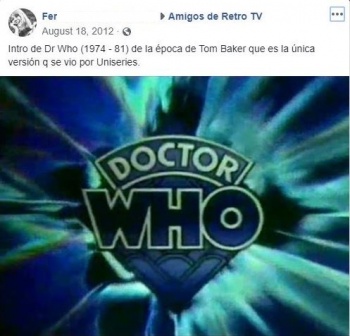Difference between revisions of "Uniseries"
John Lavalie (talk | contribs) |
Jon Preddle (talk | contribs) |
||
| Line 149: | Line 149: | ||
|3uS59CL5V_g|Generic Uniseries trailers 1990s | |3uS59CL5V_g|Generic Uniseries trailers 1990s | ||
|adytyTYNTJA|Generic Uniseries trailers 1990s | |adytyTYNTJA|Generic Uniseries trailers 1990s | ||
| + | }} | ||
| + | {{YouTube table | ||
|xTj17cl_kxw|Generic Uniseries trailers 1990s | |xTj17cl_kxw|Generic Uniseries trailers 1990s | ||
| + | |x-BJSKxhGCM|Generic Uniseries trailers 1999 | ||
}} | }} | ||
| + | |||
==External Links== | ==External Links== | ||
Revision as of 04:38, 3 July 2020
UNISERIES was a pay cable station, part of the Imagen Satelital network founded in 1990. It was based in Buenos Aires, Argentina.
Imagen Satelital operated several specialty channels, such as Infinito (for documentaries); I-Sat (music); Space (movie) and Jupiter Comic (comedies). For classic TV drama, it launched Universo Series in February 1994..
The channels were available on Cablevisión Channel 37, Multicanal 40, Telecentro 35, DirectTV 125 and cable systems in:
In September 1998, Universo Series was renamed Uniseries. Four years later, Doctor Who aired on Uniseries.
The Uniseries channel was replaced by Retro on 2 March 2003. In 2007, Imagen Satelital was bought out by the Time-Warner group. Under the new management, Retro continued for two more years, and was eventually closed down in April 2009.
DOCTOR WHO ON UNISERIES
This was the first time Doctor Who was available to multiple countries in South America
BBC Records
Stories Bought and Broadcast
TOM BAKER
It was announced on the old Outpost Gallifrey news pages in August 2001 that: "Imagen Satelital, a Latin American broadcaster, has licensed the rights to the 13th season of Doctor Who (Tom Baker's 2nd season), for Argentina, Bolivia, Chile, Paraguay and Uruguay. It could appear on the following channels after [1 October 2001]: Uniseries, Space, I. Sat, Infinito, Jupiter Comic. Good news for Latin American fans."
As noted above, it was the Uniseries channel that ultimately aired the series.
Later, according to the original This Week in Doctor Who newsletters, some of the stories being shown featured Leela and K9, which indicates that the package extended beyond season 13, and included stories from seasons 14 and 15. But with there being three separate broadcast cycles, two of which were of odd-numbered runs, does mean that the available airdates info isn't necessarily complete.
The This Week data states that the episodes had Spanish subtitles. This would be a first, since all previous South American screenings of Tom Baker stories in the late 1970s and 1980s used the copies dubbed into Spanish, while the various regional stations in Spain re-dubbed the episodes they had into their own languages.
Based on the above, the following were likely to be the stories that screened:
18 stories, 78 episodes?
| 4F | Terror of the Zygons | 4 |
| 4G | Pyramids of Mars | 4 |
| 4H | Planet of Evil | 4 |
| 4J | The Android Invasion | 4 |
| 4K | The Brain of Morbius | 4 |
| 4L | The Seeds of Doom | 6 |
| 4M | The Masque of Mandragora | 4 |
| 4N | The Hand of Fear | 4 |
| 4P | The Deadly Assassin | 4 |
| 4Q | The Face of Evil | 4 |
| 4R | The Robots of Death | 4 |
| 4S | The Talons of Weng-Chiang | 6 |
| 4V | Horror of Fang Rock | 4 |
| 4T | The Invisible Enemy | 4 |
| 4X | Image of the Fendahl | 4 |
| 4W | The Sun Makers | 4 |
| 4Y | Underworld | 4 |
| 4Z | The Invasion of Time | 6 |
Unlike other sales to Spanish-speaking countries, these episodes were in English, and aired with Spanish subtitles.
Of note, the 7-year sales period on each in this batch of stories would have expired between 2002 and 2005. That the Uniseries run suddenly concluded at the end of December 2002 - possibly even mid-story - suggests that their rights to screen these stories had the end of the year as a fixed deadline.
Transmission
The first listing for Doctor Who on the Uniseries channel reported by This Week… was on Sunday, 5 May 2002 at 9:30pm, in a half-hour block.
On that date, the Argentinian online paper El Litoral had a brief introductory piece HERE, which refers to this as the "estreno" (premiere) episode.
The online newspaper La Nación also mentioned the series on 2 June 2002.
After six weeks of single screenings, a second episode was added to the schedule, commencing Monday, 10 June 2002 at 4:30am. It's not known if this was the same as the previous 9.30pm episode or the start of a fresh cycle of stories.
By July 2002, a third episode had been added to the schedule, this run screening at 9.30am on Sundays. Again, it's not known if this was the same episode as either of the other two, or the beginning of a third separate cycle of stories. The first airdate noted for this timeslot was in the This Week bulletin covering 7 July 2002, but it's not known if this was the actual debut of the run in that slot. It's possible that slot had been running for several weeks by then.
In the This Week bulletin published 2 October 2002, it was announced that Uniseries had been airing stories featuring Leela and K9, and that they were subtitled. It's not known which of the three timeslots this news related to, or when that TARDIS team-up debuted. (This was probably the 9.30pm cycle, with the two other cycles screening different stories.)
The series had by this time been running for 22 weeks in the 9.30pm slot. For stories from season 15 to be screening by then, Uniseries must have skipped a number of serials and jumped ahead.
The 9.30am episode was dropped after 17 weeks - This Week reporting that the 27 October screening was the last. That this is an odd number either means the listings details are inaccurate (the 9.30am slot actually debuted earlier than indicated?), or the channel did stop a story part-way through. (Without confirmed listings, it is possible that the 9.30am airings were omnibus editions, and all 18 stories aired.)
The 4.30am / 9.30pm cycle continued for ten more weeks.
On 1 December 2002, La Nación included "Dr Who" at number 5 in its list of 12 programme highlights of 2002 (see clipping to the right).
The final listings found by This Week for Doctor Who on the Uniseries site was the last of the 9.30pm episodes, on Sunday, 29 December, and the last at 4.30am on Monday, 30 December 2002.
If the This Week data is complete, then 82 separate screenings took place across the three timeslots: 35 on Sunday at 9.30pm, 17 on Sundays at 9.30am, and 30 on Mondays at 4.30am.
Since only 35 episodes had aired in the 9.30pm slot, it does appear that Uniseries ended a story mid-way through. This would make sense if Uniseries only had the rights to screen the series until the end of 2002, and had to literally stop when they did irrespective of whether or not they had screened all the episodes they had acquired.
Alternatively, they didn't air an episode on 29 December, and the shorter 34 week run had concluded on 22 December instead. (This would mean that the 34 week run was made up seven 4-parters and one 6-parter, or four 4-parters and three 6-parters.)
Interestingly, if the 'package' they had acquired was indeed seasons 13, 14 and 15 in full, that's 78 episodes / 18 stories. And there are 82 airdates recorded by This Week - did Uniseries air those 78 across the three different timeslots, and repeat a 4-parter?
With there being no titles in the Uniseries guide at the time, and the lack of any historical data available online, we will never know exactly what aired on those 82 airdates.
TV listings
| ← AIRDATES ...... (CLICK ICON TO GO TO TABLE SHOWING EPISODE BREAKDOWN AND AIRDATES - N/S = story title is Not Stated) |
Our summary has been extrapolated from the This Week in Doctor Who bulletins, which were themselves pulled from Uniseries online schedules (all now long gone, although some generic pages from the station's site in 2002 - without any Doctor Who content - have been captured by the WayBack Machine - see below).
The Uniseries site did not provide any story titles for the three timeslots. If stories featuring Leela and K9 were screening by as early as October 2002, this could only be if the station aired the stories out of sequence.
Media
There are several generic Uniseries bumpers and trailers on YouTube, mostly from the late 1990s, none of which feature Doctor Who:
|
|
|
|
|
|
External Links
- Uniseries logos
- Uniseries Facebook page
- List of programmes shown on Uniseries
- Uniseries blog 1
- Uniseries blog 2
- WayBack Machine 26 May 2002



